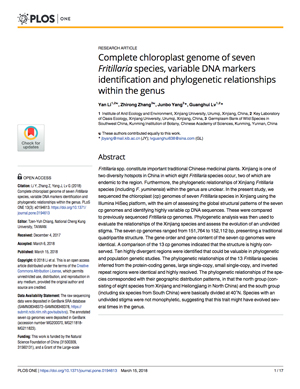NEWS 2018
Complete chloroplast genome of seven Fritillaria species, variable DNA markers identification and phylogenetic relationships within the genus
Yan LI1,2, Zhirong ZHANG3, Junbo YANG3, Guanghui LV1,2
PLoS ONE 13(3): (2018)
https://doi.org/10.1371/journal.pone.0194613
1Institute of Arid Ecology and Environment, Xinjiang University, Urumqi, Xinjiang, China
2Key Laboratory of Oasis Ecology, Xinjiang University, Urumqi, Xinjiang, China
3Germplasm Bank of Wild Species in Southwest China, Kunming Institution of Botany, Chinese Academy of Sciences, Kunming, Yunnan, China
Abstract
Fritillaria spp. constitute important traditional Chinese medicinal plants. Xinjiang is one of two diversity hotspots in China in which eight Fritillaria species occur, two of which are endemic to the region. Furthermore, the phylogenetic relationships of Xinjiang Fritillaria species (including F. yuminensis) within the genus are unclear. In the present study, we sequenced the chloroplast (cp) genomes of seven Fritillaria species in Xinjiang using the Illumina HiSeq platform, with the aim of assessing the global structural patterns of the seven cp genomes and identifying highly variable cp DNA sequences. These were compared to previously sequenced Fritillaria cp genomes. Phylogenetic analysis was then used to evaluate the relationships of the Xinjiang species and assess the evolution of an undivided stigma. The seven cp genomes ranged from 151,764 to 152,112 bp, presenting a traditional quadripartite structure. The gene order and gene content of the seven cp genomes were identical. A comparison of the 13 cp genomes indicated that the structure is highly conserved. Ten highly divergent regions were identified that could be valuable in phylogenetic and population genetic studies. The phylogenetic relationships of the 13 Fritillaria species inferred from the protein-coding genes, large single-copy, small single-copy, and inverted repeat regions were identical and highly resolved. The phylogenetic relationships of the species corresponded with their geographic distribution patterns, in that the north group (consisting of eight species from Xinjiang and Heilongjiang in North China) and the south group (including six species from South China) were basically divided at 40ÊN. Species with an undivided stigma were not monophyletic, suggesting that this trait might have evolved several times in the genus.




